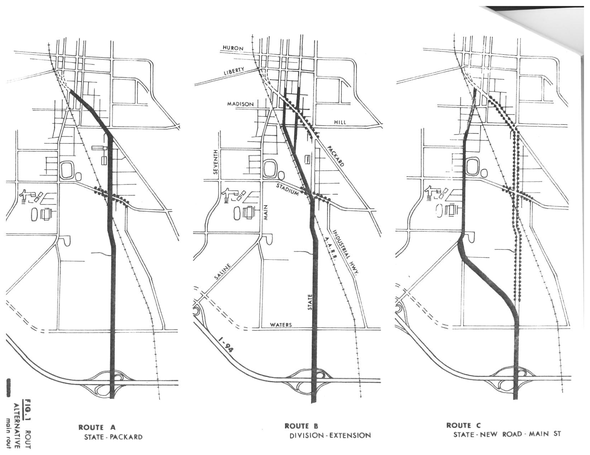FOIA Friday: Archival research of East Stadium bridge
The Ann Arbor District Library has an extensive collection of municipal documents dating from the 1960s to the present available for public inspection. They include meeting minutes, internal reports, annual reports, copies of contracts and other documents from groups ranging from the Ann Arbor Transportation Authority to the Bicentennial Committee (of 1976) to up-to-date minutes from City Council.
The collection is located on the second floor of the downtown library, behind the reference desk. Most of these are not digitized in any way, so they are fertile ground for telling part of a back story about current issues from a historical perspective.
Today's analysis picks out just one old map from one file, but it's a good one, telling a part of the story of how it came to be that the East Stadium bridge over State Street didn't get completely rebuilt when it was last redone in the mid-1970s.

None of the three proposed alignments of a "State Street Penetrator" route described in this map were ever built.
City of Ann Arbor Planning Department, August 25, 1972
In August 1972 the City of Ann Arbor Planning Department wrote a memo to the City Planning Commission with a preliminary plan for constructing a "State Street Penetrator" route, connecting Briarwood and I-94 to the center of Ann Arbor. This was part of a whole set of contemporary plans on urban redevelopment, which would have led to a high-speed thoroughfare of 6 to 8 lanes connecting straight through downtown.
The map shows three routes. Route A would have expanded South State to 8 lanes, wiping out homes along State Street in the Lower Burns Park neighborhood. Route B route would have paralleled the Ann Arbor Railroad tracks, wiping out large portions of the University of Michigan athletic practice fields and the baseball stadium. Route C would have run a big road through an area that is now full of apartments south of the University of Michigan golf course.
Needless to say, none of these alternatives got built.
How do you find this stuff?
One key to unearthing things in archives is figuring out where things are, and then sitting down with enormous piles of paper and going through them methodically. It helps to have some idea in mind when you start to look, but often a big piece of the battle is just figuring out where in the collection there might possibly be something that's relevant.
The most important portion of archival research is noting carefully enough where you found something so that you can find it again. Capture exact dates for documents, the files that you find them in, and some sense for what else is the same files. This one came from the Planning documents collection, which is separate from the Planning meeting minutes.
It's never a bad idea to talk to a librarian when you want to figure out where there are more items in the collection that might be relevant. The library has an extensive clippings file of the Ann Arbor News, collected in bound volumes, that goes to about 2003. For any item you find, there may well be more that you can locate once you figure out who else to talk to.
Writing from the archival record
The easiest way to write from archives is to find something that you can scan in and share that directly.
The library has a digital scanner that will let you take individual pages from any of the documents, scan them in, and store them onto a USB drive or send them via email.
The sorts of reports, documents, minutes, and other official bureaucratic debris that gets collected in this type of archive don't tell warm, human, personal stories. Most officials who are writing things are writing for a professional, official audience, and the text can be very dry. Citizens whose contributions to the written record have been captured are writing to accomplish or to prevent some particular task, and they are often polite and formal in this written form.
Archival search vs. FOIA
FOIA is the worst possible search engine in the world, but at least the person who is searching for records on your behalf is already familiar with the records and the people who currently hold them. You get help in looking, and so rather than spending hours in the library you can just wait a week or three and pay a few bucks for the results you get.
When you search through archives, all of the onus is on you to find things. Some of the librarians will know more of what you are looking for at the start, but once you start digging you quickly become the only expert in the world on that particular bit of dusty paper.
FOIA requests recently received
I was just at City Hall and picked up two of the requests that had come in: one regarding the HAWK pedestrian signal proposed for Huron Street near the YMCA, and one on the appraisal for the acquisition a portion of the Elks property on Sunset.
With any of the FOIA requests you get, you never really know whether you will find anything worth writing about as a result.
Edward Vielmetti is fond of maps of things that have never been built. Reach him at 734-330-2465.
